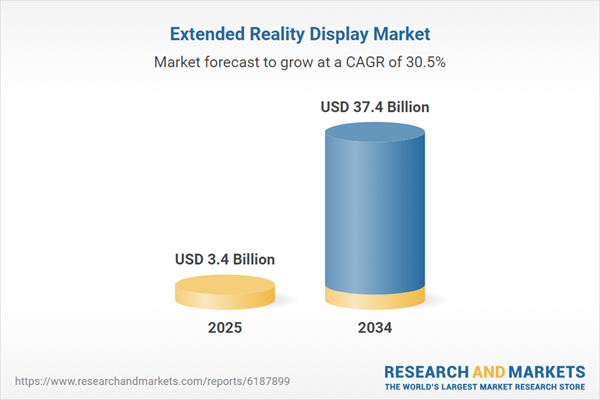Extended Reality Display Market Overview
The extended reality (XR) display market is witnessing rapid expansion, driven by the increasing adoption of immersive technologies across industries such as gaming, healthcare, retail, education, and industrial applications. XR encompasses virtual reality (VR), augmented reality (AR), and mixed reality (MR), each requiring advanced display solutions for enhanced user experience. The demand for high-resolution, lightweight, and power-efficient XR displays is accelerating as developers focus on improving image clarity, reducing latency, and enhancing field-of-view. OLED, microLED, and liquid crystal on silicon (LCoS) technologies are emerging as key enablers of high-performance XR displays. The rise of the metaverse, increasing enterprise investments in XR-based training and collaboration tools, and the evolution of AI-driven visual enhancements are further fueling market growth. However, challenges such as display cost, power consumption, and motion sickness issues remain critical areas of improvement for manufacturers.the XR display market has seen substantial technological advancements and industry-wide adoption. Leading tech firms have introduced next-generation headsets with higher refresh rates, improved pixel densities, and enhanced eye-tracking capabilities. MicroLED displays have gained significant traction due to their superior brightness, longevity, and energy efficiency compared to traditional OLED and LCD options. The push for compact, lightweight form factors has driven innovations in waveguide optics and pancake lenses, reducing headset bulk and improving comfort. Cloud-based XR rendering has gained momentum, allowing devices to offload processing power to remote servers, enabling smoother and more detailed virtual experiences. In addition, the gaming industry continues to be a key driver, with new XR-compatible game titles and haptic feedback integration enhancing user immersion. Meanwhile, enterprise applications of XR displays in remote collaboration, industrial training, and medical simulations have expanded, solidifying XR’s role beyond entertainment.
The XR display market is expected to experience transformative growth with the rise of AI-powered adaptive displays and ultra-high-resolution panels. AI will enhance rendering efficiency by dynamically adjusting display parameters based on user gaze and environmental conditions, optimizing performance without excessive power consumption. The emergence of quantum dot and holographic display technologies will further push the boundaries of XR visuals, providing richer colors and enhanced depth perception. Wireless XR solutions leveraging 6G connectivity will unlock new possibilities for real-time streaming and cloud-rendered XR experiences. Moreover, advancements in biometric sensors will enable personalized user interactions, improving accessibility and reducing motion sickness. As XR technology integrates deeper into retail, automotive, and smart city applications, demand for compact, low-power, and ultra-responsive displays will intensify. Regulatory frameworks around privacy, safety, and digital well-being in XR environments will also shape market developments, ensuring responsible and secure adoption of immersive displays.
Key Insights: Extended Reality Display Market
- Rise of MicroLED and Quantum Dot Displays: MicroLED and quantum dot technologies are revolutionizing XR displays with improved brightness, color accuracy, and energy efficiency, enhancing immersive experiences while reducing power consumption.
- AI-Driven Adaptive Display Optimization: AI is being integrated into XR displays to dynamically adjust brightness, resolution, and contrast based on user gaze and environmental lighting, optimizing performance and reducing eye strain.
- Cloud-Based XR Rendering and 6G Connectivity: The shift toward cloud-based XR processing, combined with the anticipated rollout of 6G networks, is enabling ultra-low-latency, high-fidelity virtual environments streamed directly to headsets.
- Advancements in Lightweight and Ergonomic XR Displays: Innovations in optical waveguides, pancake lenses, and ultra-light materials are making XR headsets more compact and comfortable for extended use.
- Holographic and Spatial Light Modulator (SLM) Displays: The development of holographic and SLM-based displays is pushing the boundaries of XR realism, allowing for lifelike depth perception and 3D visualization without bulky headsets.
- Growing Adoption of XR in Enterprise and Industrial Applications: Businesses are increasingly leveraging XR displays for employee training, remote collaboration, and digital twins, driving demand for high-performance XR visualization solutions.
- Expansion of the Gaming and Entertainment Industry: The demand for immersive gaming experiences and interactive storytelling is accelerating the adoption of high-refresh-rate and ultra-responsive XR displays.
- Advancements in Display Manufacturing Technologies: Improvements in OLED, microLED, and waveguide optics are making XR displays more efficient, affordable, and visually compelling, driving wider consumer and enterprise adoption.
- Rising Investments in the Metaverse and Spatial Computing: Tech giants are pouring resources into metaverse development, requiring high-quality XR displays to deliver lifelike digital experiences and virtual workspaces.
- High Costs and Power Consumption of XR Displays: The production of advanced XR displays remains expensive, and high power consumption limits battery life, posing challenges for widespread adoption, particularly in standalone XR devices.
Extended Reality Display Market Segmentation
By Display Type
- Liquid Crystal Displays (LCD)
- Organic Light-Emitting Diode (OLED)
- Other Display Type
By Component
- Hardware
- Software
- Services
By Solution
- Business Engagement
- Consumer Engagement
By Application
- Augmented Reality
- Mixed Reality
- Virtual Reality
By End-User Industry
- Gaming and Entertainment
- Healthcare
- Education
- Military and Defense
- Automotive and Manufacturing
- Retail
- Other End-Users
Key Companies Analysed
- Apple Inc.
- Alphabet
- Samsung Electronics Co. Ltd.
- Microsoft
- Meta Platforms Inc.
- Dell Technologies Inc.
- Sony Corporation
- HP Development Company L.P.
- Accenture PLC
- Qualcomm Technologies Inc.
- Koninklijke Philips N.V.
- Vuzix Corporation
- Seiko Epson Corporation
- Japan Display Inc.
- PTC Inc.
- Niantic Inc.
- Tata Elxsi Limited
- Magic Leap
- MAGIC LEAP Inc.
- HTC Corporation
- EON Reality Inc.
- Talespin Reality Labs Inc.
- Kopin Corporation
- Varjo Technologies Oy
- Zappar
- SphereGen Technologies LLC
- Metaio
- Softweb Solutions Inc.
Extended Reality Display Market Analytics
The report employs rigorous tools, including Porter’s Five Forces, value chain mapping, and scenario-based modeling, to assess supply-demand dynamics. Cross-sector influences from parent, derived, and substitute markets are evaluated to identify risks and opportunities. Trade and pricing analytics provide an up-to-date view of international flows, including leading exporters, importers, and regional price trends.Macroeconomic indicators, policy frameworks such as carbon pricing and energy security strategies, and evolving consumer behavior are considered in forecasting scenarios. Recent deal flows, partnerships, and technology innovations are incorporated to assess their impact on future market performance.
Extended Reality Display Market Competitive Intelligence
The competitive landscape is mapped through proprietary frameworks, profiling leading companies with details on business models, product portfolios, financial performance, and strategic initiatives. Key developments such as mergers & acquisitions, technology collaborations, investment inflows, and regional expansions are analyzed for their competitive impact. The report also identifies emerging players and innovative startups contributing to market disruption.Regional insights highlight the most promising investment destinations, regulatory landscapes, and evolving partnerships across energy and industrial corridors.
Countries Covered
- North America - Extended Reality Display market data and outlook to 2034
- United States
- Canada
- Mexico
- Europe - Extended Reality Display market data and outlook to 2034
- Germany
- United Kingdom
- France
- Italy
- Spain
- BeNeLux
- Russia
- Sweden
- Asia-Pacific - Extended Reality Display market data and outlook to 2034
- China
- Japan
- India
- South Korea
- Australia
- Indonesia
- Malaysia
- Vietnam
- Middle East and Africa - Extended Reality Display market data and outlook to 2034
- Saudi Arabia
- South Africa
- Iran
- UAE
- Egypt
- South and Central America - Extended Reality Display market data and outlook to 2034
- Brazil
- Argentina
- Chile
- Peru
Research Methodology
This study combines primary inputs from industry experts across the Extended Reality Display value chain with secondary data from associations, government publications, trade databases, and company disclosures. Proprietary modeling techniques, including data triangulation, statistical correlation, and scenario planning, are applied to deliver reliable market sizing and forecasting.Key Questions Addressed
- What is the current and forecast market size of the Extended Reality Display industry at global, regional, and country levels?
- Which types, applications, and technologies present the highest growth potential?
- How are supply chains adapting to geopolitical and economic shocks?
- What role do policy frameworks, trade flows, and sustainability targets play in shaping demand?
- Who are the leading players, and how are their strategies evolving in the face of global uncertainty?
- Which regional “hotspots” and customer segments will outpace the market, and what go-to-market and partnership models best support entry and expansion?
- Where are the most investable opportunities - across technology roadmaps, sustainability-linked innovation, and M&A - and what is the best segment to invest over the next 3-5 years?
Your Key Takeaways from the Extended Reality Display Market Report
- Global Extended Reality Display market size and growth projections (CAGR), 2024-2034
- Impact of Russia-Ukraine, Israel-Palestine, and Hamas conflicts on Extended Reality Display trade, costs, and supply chains
- Extended Reality Display market size, share, and outlook across 5 regions and 27 countries, 2023-2034
- Extended Reality Display market size, CAGR, and market share of key products, applications, and end-user verticals, 2023-2034
- Short- and long-term Extended Reality Display market trends, drivers, restraints, and opportunities
- Porter’s Five Forces analysis, technological developments, and Extended Reality Display supply chain analysis
- Extended Reality Display trade analysis, Extended Reality Display market price analysis, and Extended Reality Display supply/demand dynamics
- Profiles of 5 leading companies - overview, key strategies, financials, and products
- Latest Extended Reality Display market news and developments
Additional Support
With the purchase of this report, you will receive:- An updated PDF report and an MS Excel data workbook containing all market tables and figures for easy analysis.
- 7-day post-sale analyst support for clarifications and in-scope supplementary data, ensuring the deliverable aligns precisely with your requirements.
- Complimentary report update to incorporate the latest available data and the impact of recent market developments.
This product will be delivered within 1-3 business days.
Table of Contents
Companies Mentioned
- Apple Inc.
- Alphabet
- Samsung Electronics Co. Ltd.
- Microsoft
- Meta Platforms Inc.
- Dell Technologies Inc.
- Sony Corporation
- HP Development Company L.P.
- Accenture PLC
- Qualcomm Technologies Inc.
- Koninklijke Philips N.V.
- Vuzix Corporation
- Seiko Epson Corporation
- Japan Display Inc.
- PTC Inc.
- Niantic Inc.
- Tata Elxsi Limited
- Magic Leap
- MAGIC LEAP Inc.
- HTC Corporation
- EON Reality Inc.
- Talespin Reality Labs Inc.
- Kopin Corporation
- Varjo Technologies Oy
- Zappar
- SphereGen Technologies LLC
- Metaio
- Softweb Solutions Inc.
Table Information
| Report Attribute | Details |
|---|---|
| No. of Pages | 160 |
| Published | October 2025 |
| Forecast Period | 2025 - 2034 |
| Estimated Market Value ( USD | $ 3.4 Billion |
| Forecasted Market Value ( USD | $ 37.4 Billion |
| Compound Annual Growth Rate | 30.5% |
| Regions Covered | Global |
| No. of Companies Mentioned | 28 |









